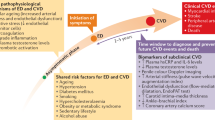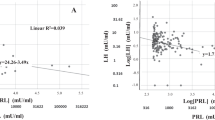Abstract
Erectile dysfunction is one of the major obstacles for noncompliance in the antihypertensive treatment. It has been shown that various antihypertensive drugs have a negative influence on sexual activity such as diuretics and β-blockers. Thus, the purpose of the present study was to evaluate the effect of valsartan, an AT1-receptor antagonist, or its combination with hydrochlorothiazide on sexual activity in hypertensive patients. A total of 2202 patients (mean age 54±8 years) with hypertension systolic blood pressure (SBP)⩾140 mmHg, diastolic blood pressure (DBP)⩾95 mmHg), or with pretreated hypertension, were included in the present analysis. Blood pressure was measured at baseline, after 8 and 16 weeks, respectively. Sexual activity was assessed with a questionnaire at each of the three visits. Sexual activity (intercourse per week) was determined in three groups: controls (n=27; conventional therapy); valsartan group (n=1899); valsartan in combination with hydrochlorothiazide (n=276). There were 26 drop outs. SBP (−18.6 mmHg) and DBP (−11.6 mmHg) decreased significantly in all three groups. Sexual activity decreased slightly in controls from 1.3 to 0.9 times per week (NS), whereas it increased in the valsartan group from 1.0 to 1.6 times during follow-up (P<0.0001). Similarly, sexual activity increased in the combination group from 0.9 to 1.3 times per week during follow-up (P<0.0001). No sexual activity was reported by 467 (21%) of the 2202 patients at baseline and 154 (7%) at 16 weeks follow-up (P<0.05). Impaired sexual activity is common in hypertensive patients (app. 20%). Valsartan increases the rate of sexual intercourses per week, whereas conventional therapy affects sexual activity adversely.
This is a preview of subscription content, access via your institution
Access options
Subscribe to this journal
Receive 12 digital issues and online access to articles
$119.00 per year
only $9.92 per issue
Buy this article
- Purchase on Springer Link
- Instant access to full article PDF
Prices may be subject to local taxes which are calculated during checkout





Similar content being viewed by others
References
Rosen RC . Sexual dysfunction as an obstacle to compliance with anithypertensive therapy. Blood Press 1997; 6 (Suppl 1): 47–51.
Bulpitt CJ, Dollery CT . Side effects of hypotensive agents evaluated by a self-administered questionnaire. BMJ 1973; 3: 485–490.
Wassertheil-Smoller S et al. for the TAIM Research Group. Effects of anithypertensives on sexual function and quality of life; the TAIM Study. Ann Intern Med 1991; 114: 613–620.
Chang SW et al. The impact of diuretic therapy on reported sexual function. Arch Intern Med 1991; 151: 2402–2408.
Beto JA, Bansal VK . Quality of life in treatment of hypertension. A meta-analysis of clinical trials. Am J Hypertens 1992; 5: 125–133.
Croog SH et al. Sexual symptoms in hypertensive patients. A clinical trial of antihypertensive medications. Arch Intern Med 1988; 148: 788–794.
Smith PJ, Talfert RL . Sexual dysfunction with antihypertensive and antipsychotic agents. Clin Pharmacol 1986; 5: 373–384.
Kostis JB, Rosen RC, Holzer BC, Miller MH . CNS effects of centrally active antihypertensive agents: a prospective, placebo controlled study of sleep, mood state, cognitive and sexual function in hypertensive males. Psychopharmacology 1990; 102: 163–170.
Miller RA . Propranolol and impotence. Ann Intern Med 1976; 85: 682–683.
Burnett WC, Chahine RA . Sexual dysfunction as a complication of propranolol therapy in men. Cardiovasc Med 1979; 4: 811–815.
Suzuki H, Tominaga T, Kumagai H, Saruta T . Effects of first-line anithypertensive agents on sexual function and sex hormones. J Hypertens 1988; 6 (Suppl 4): S649–S651.
Fogari R et al. Sexual function in hypertensive males treated with lisinopril or atenolol. A cross-over study. Am J Hypertens 1998; 11: 1244–1247.
Croog SH et al. The effects of antihypertensive therapy on the quality of life. N Engl J Med 1986; 314: 1657–1664.
Williams GH et al. Impact of anithypertensive therapy on quality of life: effect of hydrochlorothiazide. J Hypertens 1987; 5 (Suppl 1): S29–S35.
Fletcher AE et al. The effects of verapamil and propranolol on quality of life in hypertension. J Hum Hypertens 1989; 3: 125–130.
Greenberg G, Brennen PJ, Miall WE . Effect of diuretic and beta-blocker therapy in the medical research council. Am J Med 1984; 76: 45–51.
Grimm R et al. Long-term effects on sexual function of five antihypertensive drugs and nutritional hygienic treatment in hypertensive men and women in the Treatment of Mild Hypertension Study (THOMS). Hypertension 1997; 29: 8–14.
Fogari R et al. Sexual activity in hypertensive men treated with valsartan or carvedilol: a cross-over study. Am J Hypertens 2001; 14: 27–31.
Fogari R et al. Sexual activity and plasma testosterone in hypertensive men treated with valsartan or atenolol. Am J Hypertens 2001; 14 (Part 2) 97A.
Williams GH . Assessing patient wellness: new perspectives on quality of life and compliance. Am J Hypertens 1998; 11 (Suppl): 186S–191S.
Kifor I et al. Tissue angiotensin II as a modulator of erectile function. I—Angiotensin peptide content, secretion and effects in the corpus cavernosum. J Urol 1997; 157: 1920–1925.
Acknowledgements
This work was supported by an educational grant of Novartis AG, Bern.
Author information
Authors and Affiliations
Corresponding author
Rights and permissions
About this article
Cite this article
Chiesa, A., Pfiffner, D., Meier, B. et al. Sexual activity in hypertensive men. J Hum Hypertens 17, 515–521 (2003). https://doi.org/10.1038/sj.jhh.1001580
Received:
Revised:
Accepted:
Published:
Issue Date:
DOI: https://doi.org/10.1038/sj.jhh.1001580
Keywords
This article is cited by
-
Effects of Major Antihypertensive Drug Classes on Erectile Function: a Network Meta-analysis
Cardiovascular Drugs and Therapy (2022)
-
Deterioration of sexual function is associated with central hemodynamics in adult Japanese men
Hypertension Research (2020)
-
The Different Therapeutic Choices with ARBs. Which One to Give? When? Why?
American Journal of Cardiovascular Drugs (2016)
-
A review of the positive and negative effects of cardiovascular drugs on sexual function: a proposed table for use in clinical practice
Netherlands Heart Journal (2014)
-
Antihypertensive Treatment and Sexual Dysfunction
Current Hypertension Reports (2012)



